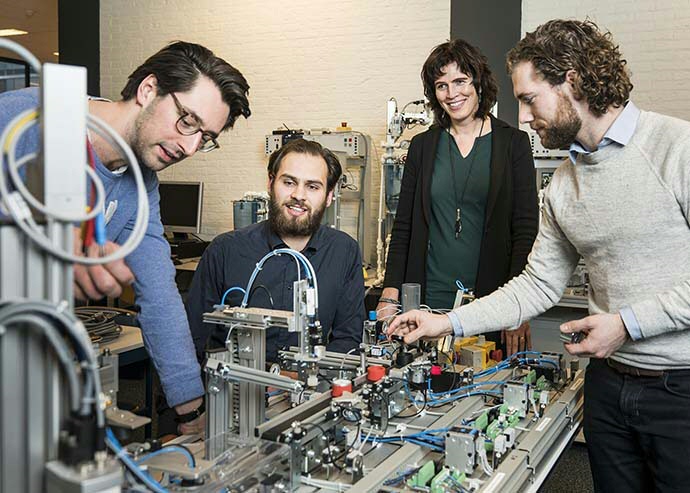Dutch Universities shine a light on essential Design Engineering Sciences sector

“Technology and Society in Equilibrium” – a new sector portrait for Design Engineering Sciences - has been presented to the Ministry of Education, Culture and Science. The report paints a picture of this unique sector which includes the disciplines of Industrial Design Engineering, Architecture, Technology, Policy & Management. In particular it highlights the sector’s role in connecting technological developments with the needs of people and society, thereby helping solve some of the most urgent societal challenges.
On 23 June 2021 Ena Voûte, dean of Delft University of Technology | Faculty of Industrial Design Engineering and Professor Karin Schroen of Wageningen University and Research handed the report to the Ministry’s Research and Science Policy team. Policy Director Oscar Delnooz accepted the report enthusiastically, commenting that: “We are pleased that the design engineering sciences have joined forces and have taken the initiative to draw up a joint sector portrait.”
Louise O. Fresco, chair of 4TU Federation (representing the Netherlands’ four technical universities) called for recognition of the sector: “the Design Engineering Sciences are an indispensable addition to the STEM disciplines. […] The crucial contribution […] is to develop knowledge and methods for designing integrated solutions - in conjunction with the environment and together with stakeholders from society."
Distinct role of design in embedding technology in society valued by other sectors
The portrait presents design as a transdisciplinary activity: knowledge from different scientific disciplines comes together in teams, processes and methods, which bridge the gap between new technology and the needs of people and society. The design engineering sciences are seen as essential for architects and designers working in practice, as well as by other sectors dealing with complex societal challenges. Take healthcare as an example:
- Ernst Kuipers, CEO Erasmus MC - “Design is of crucial importance for the full gamut of healthcare, from citizens, to patients and family members, all the way through to healthcare professional”.
- Paul Gardien, Head Design Strategy & Innovation, Philips underlines the crucial role of design methods in stakeholders management: “Philips has a clear mission improve people’s health and well-being through meaningful innovation. To achieve our mission we believe that user experience can make or break outcomes, and design can make or break the experience. Next to this we believe that we cannot do that alone, involvement of all stakeholders early on in the process is vital for success. This requires a shared vocabulary and toolset, the key enabling methodologies, are critical to achieve sustainable outcomes at a personal and societal level.”
- Mark van Houdenhoven, CEO of the Maartenskliniek in Nijmegen, values the sector’s contribution to improving the healthcare system as a whole, to “[…]design and optimize new processes and organizational models, and analyse them prospectively through quantitative analysis and (simulation) models. This is essential to overcome the mostly inefficient ways of working with an evidence-based approach in this risk-averse sector."
Future generation of designers needed in response to societal challenges
Design interventions, the report explains, are used to test hypotheses and render future scenarios in such a form that people can imagine, understand, experience, touch and debate, bringing the possibility of societal changes closer to fruition. By educating a future generation of (academic) professionals in this approach, and arming them with the mind-set and design methodologies, design can be part of an increasingly effective response to the Netherland’s mission-driven innovation policy.
Sector portrait as a starting point for sector plan
The sector portrait is the result of an extensive and intensive two-year process, involving more than 25 people from the four Dutch universities of technology (Delft, Eindhoven, Twente and Wageningen) and the University of Groningen. It is seen as a starting point for further development and possible future funding supporting:
- Knowledge Creation: more research activities (and the financial support to enable this) are needed to develop and validate the Key Enabling Technologies and research the effect of designs in context.
- Expansion of educational capacity: the sector currently educates some 18,000 per year students in the Netherlands. In order to respond to growing demand for designers, the sector must expand its educational capacity without increasing the student/staff ratio which would jeopardise educational quality.
- Access to Technology: The OIW needs access to the knowledge behind new and emerging technologies continuously via well trained staff. business and society needs continual access to rapidly developing new technologies. Design can make this happen.
| Last modified: | 28 June 2021 10.30 a.m. |
More news
-
03 April 2025
IMChip and MimeCure in top 10 of the national Academic Startup Competition
Prof. Tamalika Banerjee’s startup IMChip and Prof. Erik Frijlink and Dr. Luke van der Koog’s startup MimeCure have made it into the top 10 of the national Academic Startup Competition.
-
01 April 2025
NSC’s electoral reform plan may have unwanted consequences
The new voting system, proposed by minister Uitermark, could jeopardize the fundamental principle of proportional representation, says Davide Grossi, Professor of Collective Decision Making and Computation at the University of Groningen
-
01 April 2025
'Diversity leads to better science'
In addition to her biological research on ageing, Hannah Dugdale also studies disparities relating to diversity in science. Thanks to the latter, she is one of the two 2024 laureates of the Athena Award, an NWO prize for successful and inspiring...
